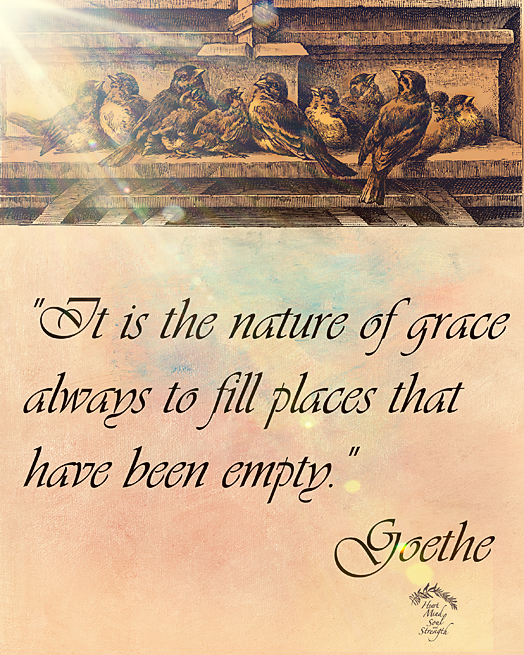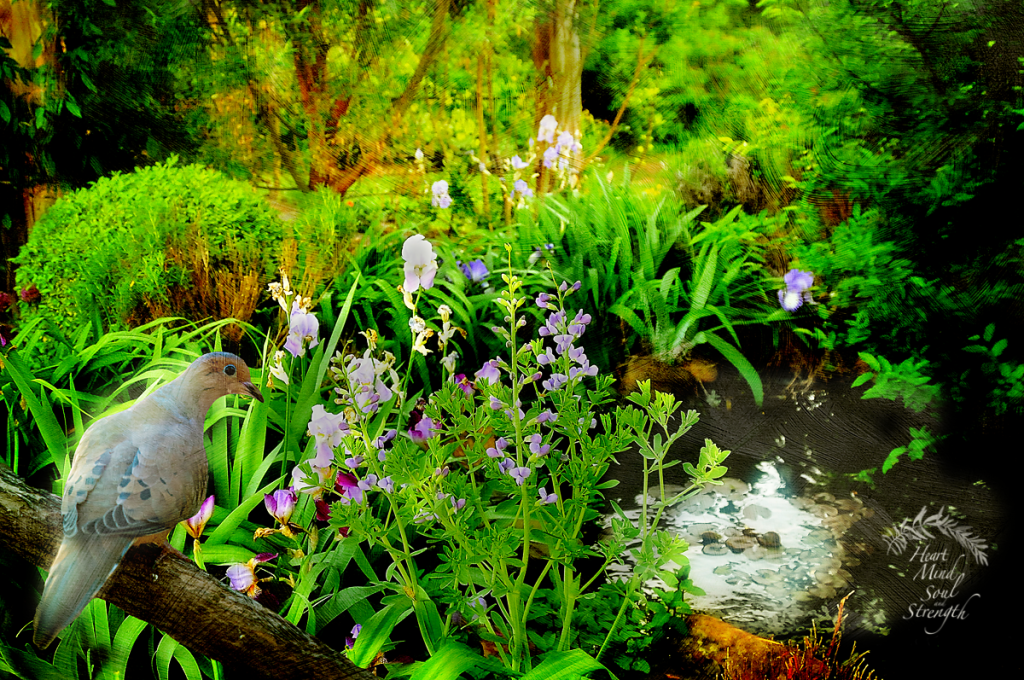
One of the delights of Spring is birds. What cheers the heart more than birds? Their antics distract us from our daily grind and refresh our weary minds. This week I noticed an especially busy robin in the yard. Strangely, he looked like he had a handlebar mustache! A second look disclosed why. He was industriously picking up dried grass which was sticking out both sides of his beak, looking just like a blond, bushy mustache. I was intrigued that he was so judicious in his choice of grass. There was not one green spear of grass in his beak, only dried grass fit for his nest.
Each morning the purple martins give an aerial acrobatic show: swiftly gliding, diving, swooping low then effortlessly rising high. Their exuberance is a pleasure to behold and hear. Lilting giggles fill the air as if they are so happy to be alive on a sunny Spring morning.
My granddaughter pauses and comments on the woodpecker in the neighbor’s trees. The geese holler overhead and the duck timidly squeaks in the pond. Free entertainment for the alert and the unrushed. A children’s book called, “Bird Talk”, by Lita Judge explains the meaning of many bird calls: “The American Robin sings hundreds of different songs. The more complicated his song, the more he says, ‘I have the most experience. I’ll make the best mate.’ The melodious song and bright colored feathers of an American Goldfinch say, ‘Choose me, I’m the healthiest.’” In addition to auditioning for a mate, birds communicate with one another to sound the alert to danger or to distract a predator; to encourage a chick to exit its egg or a fledgling to fly.
Have you stopped recently to revel in the Creator’s celebration of new life?

I enjoy a free phone app from the ornithology department of Cornell University. I can search their database in order to identify a particular bird I’ve spotted. The interface is user-friendly asking simple questions such as relative size, feather colors, and your location. Then several species’ images are given as the possible species I have sighted. The app makes it easy to access interesting facts about any given species as well as recordings of their calls and songs which are such good audio that real birds are fooled when I play them. Get the free phone app in the App Store by searching Merlin Bird ID of Cornell University Ornithology.
Here are some hints for encouraging birds to frequent your corner of the world:
Provide safe shelter. Birdhouses aren’t all the same. Different birds need different sized holes in their house. If you want to attract small songbirds, don’t offer a house with a large opening. Go here to find the optimum hole sizes for different species: http://birding.about.com/od/birdhouses/a/birdhouseholes.htm If you have predators like squirrels, cats or large, aggressive birds, who doesn’t? re-enforce the opening with metal or an extra layer of wood so baby birds don’t become lunch while they’re undeveloped and vulnerable in the nest. Also, remove the perch which provides handholds for predators. Site the house at least 5 feet from brush where predators can hide. Avoid bright colors on the exterior. Instead, choose natural colors like brown or green that conceal the nest and attract nesting pairs.
Provide healthy shelter. Choose birdhouses with access so you can clean the box after nesting season. A hinged roof or sliding floor make it easy to throw away nesting materials and spray with a bleach solution to rid the box of lice and bacteria. A safe bleach solution is one part bleach to nine parts water. Rinse with water and allow to dry in the sun. Don’t paint the inside of the house.
Provide comfortable shelter. Make sure to position the house so the opening doesn’t face the prevailing winds or direct sunlight. An overhang will prevent rain from entering the nest. Full or partial shade keeps the temps down as does ventilation holes at the tops of the walls for air flow. Choose interior dimensions appropriate for the birds you want to attract.
To read further: http://birding.about.com
Provide Food-Bearing Plants. “Take the Carolina Chickadee: A single clutch of four to six chicks will gobble up more than 9,000 caterpillars in the 16 days between when they hatch and when they leave the nest. So thriving insects mean thriving birds.” Did you know that 96% of North American birds raise their young on insects and caterpillars? Remember that trees and shrubs provide food for birds in two ways: hosting caterpillars and insects the birds need to raise young and providing fruits and seeds later in the season for adult bird sustenance. This blog is read by ladies from Great Britain to China, so I don’t want to assume to list all the plants suitable to your climate. Suffice it to say that planting trees and shrubs which bear fruit that can sustain birds is a worthwhile investment and worth considering next time you’re planting. The main principle to follow is to choose plants that are native to your area. “Native plants are also a critical part of the food chain—insects evolved to feed on native plants, and by and large, backyard birds raise their young on insects, explains Douglas Tallamy, the author of Bringing Nature Home. Take the Carolina Chickadee: A single clutch of four to six chicks will gobble up more than 9,000 caterpillars in the 16 days between when they hatch and when they leave the nest. So thriving insects mean thriving birds.” Planting native plants that don’t require artificial fertilizers and pesticides helps the whole food chain. Here is a list of North American vines, shrubs and trees that birds love: Hummingbirds and butterflies are drawn to these nectar-bearing flowers: bee balm, butterfly bush, salvia, trumpet vine, echinacea (coneflower). Seed/fruit bearing plants: sunflowers, milkweed, Virginia Creeper, Elderberry, Dogwood. Virginia Creeper looks a bit like poison ivy but is harmless. We had huge vines growing up our house in Eastern Tennessee that were native and were volunteers, not planted by us. Because the vine was around our bedroom windows, we got an up-close view of the birds enjoying the tiny fruit in the Fall and Winter. However, my husband was less than thrilled with this fast growing vine because it clings to house siding with little suction cup roots that are nearly impossible to clean off when painting time rolls around. I’d suggest growing Virginia Creeper on something that won’t need to be painted in the future. Trees provide safety and nesting places as well as moth and butterfly caterpillars which sustain nestlings with fat and protein. Consider planting a native oak, ash, maple, cherry, plum, or willow. Let me emphasize the key word is Native. Look up plants native to your area and ask the nursery worker for those particular cultivars. Some local nurseries specialize in real native species. If you choose to feed birds with purchased seed, be consistent in providing food.

Provide water. Even a small garden pond will attract all manner of birds to your yard. We once used a discarded hot tub for a pond. We asked the excavator to dig a hole while he was back-filling our foundation. With a bit of hand shoveling, we positioned the broken hot tub in the hole. After lining it with plastic, we covered the bottom with gravel, filled it with water and stocked it with $.10 goldfish and a few water lilies. Oh, the enjoyment we got from seeing and hearing the myriad birds, and, of course, the frogs! Much later we added a tiny fountain to keep the water circulating and aerated, but it isn’t necessary if you site the pond in shade to keep algae down. Whole books have been written on siting, digging and caring for ponds of all sizes, but don’t be intimidated. You can do it simply and creatively. Remember safety considerations if you have young children around. Shallow ponds or just running water over rocks circulated by a pump provides water for birds and enjoyment for you and the children. If you choose to have birdbath instead, clean it weekly in hot weather. Dump out the water, wipe with a bleach/water solution and rinse well. Some folks provide cold weather water with a heating element made for keeping birdbaths unfrozen.
P.S. Perhaps a birdhouse or birdbath would make a good Mother’s Day gift. For a memorable gift that will give her enjoyment for many years, offer to help with making a water feature in her yard or hire a professional to do it. Perhaps several siblings could go together to pay for this project for a combined Mother’s Day/Father’s Day gift.
For further reading:
https://www.audubon.org/news/10-plants-bird-friendly-yard
https://www.allaboutbirds.org/landscaping-for-birds-7-important-plant-groups/
https://www.allaboutbirds.org/the-best-plants-and-trees-to-plant-for-birds-a-starter-list/